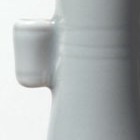J.J. Lally & Co., Oriental Art / New York City, New York
MenuPast Exhibition
Chinese Ceramics A.D. 400–1400:
Selections from an American Collection
March 19 - 31, 2007
25.
A PAIR OF SMALL LONGQUAN CELADON VASES
Yuan Dynasty (A.D. 1279-1368)
following the form of a bonze tou hu ‘arrow vase’, each pear-shaped vase with sloping shoulders tapering up to a cylindrical neck flanked by small tubular handles joined by an incised triple-line band, the handles also with incised line borders and the lip with moulded rim, covered with a glossy sea-green glaze of even tone continuing over the recessed base, the high ring foot with unglazed edge showing the gray stoneware burnt reddish-brown in the firing.
Height 6 1⁄2 inches (16.5 cm)
From the Collection of R.T.A. Riesco, London, no. 220
A bronze vase of very similar form found in the cargo of the ‘Sinan wreck’, a Chinese ship which sank in 1323 off the coast of Korea is illustrated in the catalogue entitled Special Exhibition of Cultural Relics Found off Sinan Coast, National Museum of Korea, Seoul, 1977, fig. 287.
These small vases were made for use as flower vases, but their form is based on the shape of larger bronze vessels (tou hu) which were used as the target in a drinking game in which contestants tossed arrows at the mouth or handles of the vessel. The game is mentioned in the Zhouzhuan (Zuo Commentary on the Spring and Autumn Annals, attributed to Zuoqiu Ming, circa 5th-6th Century B.C.), and its rules and etiquette are set down in detail in the Liji, one of the Confucian classics. Interest in the game was revived by Song literati, and the vessel shape, associated with antiquity and with contemporary scholar-elites, was revived by Song potters and remained popular through the Ming dynasty.
A late Ming bronze tou hu vase with twin tubular handles on the neck in the Shanghai Museum is illustrated by Li and Watt, eds., The Chinese Scholar’s Studio, Asia Society, New York, 1987, no. 63, with a detailed caption by Mowry on p. 178 which provides the capsule history of the vessel form cited above.
